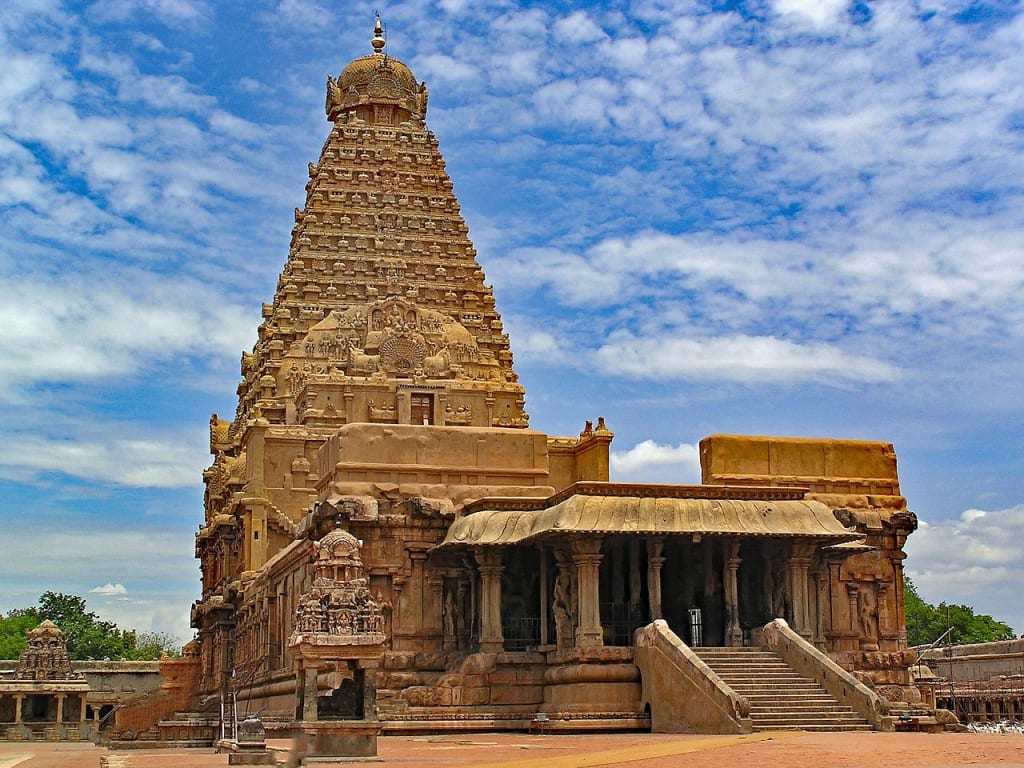
The Brihadeeswarar Temple in Thanjavur, India, also known as the Big Temple, was built by King Raja Raja Chola I in the 11th century. Completed in 1010 AD, it is a UNESCO World Heritage Site. The temple is dedicated to Lord Shiva and showcases remarkable Dravidian architecture. The central deity, a massive Shiva lingam, is housed in the sanctum sanctorum. The temple complex includes a towering vimana, a massive Nandi statue, and intricate carvings depicting Chola art and culture. The Brihadeeswarar Temple remains an iconic symbol of Chola dynasty's architectural and artistic prowess.
The Brihadeeswarar Temple, constructed during the Chola dynasty's reign, specifically by Raja Raja Chola I, stands as a testament to the grandeur of Dravidian architecture. Here are more details:
1. **Architecture:** The temple follows the traditional Dravidian architectural style, characterized by its towering vimana (temple tower), massive entrance gateways (gopurams), and intricate carvings. The vimana rises to a height of about 66 meters (216 feet), making it one of the tallest temple towers in India.
2. **Construction Material:** The temple is primarily made of granite, and the sheer size of the stones used in its construction is impressive. The capstone of the vimana, for instance, weighs about 80 tons and was lifted to its position without the use of cranes.
3. **Nandi Statue:** At the entrance, there is a colossal Nandi (bull), Lord Shiva's mount, carved out of a single granite block, measuring about 16 feet in length and 13 feet in height.
4. **Frescos and Murals:** The temple walls feature frescoes and murals portraying scenes from Hindu mythology, the life of Raja Raja Chola I, and the cultural practices of the time.
5. **Peruvudaiyar Kovil Inscription:** The temple has inscriptions on its walls, providing valuable historical information about the Chola dynasty, its administration, and the temple's construction process. The inscriptions are in Tamil and Grantha scripts.
6. **Shikhara:** The main sanctum's shikhara (tower) is capped with a monolithic granite block weighing around 25 tons.
7. **Nataraja Shrine:** Within the temple complex, there is a separate shrine for Lord Nataraja, the cosmic dancer, showcasing a remarkable representation of Lord Shiva in his dancing form.
The Brihadeeswarar Temple remains a marvel of ancient Indian architecture, attracting visitors and scholars from around the world to admire its cultural, historical, and religious significance.
Certainly, here are further details about the Brihadeeswarar Temple:
1. **Construction Purpose:** Raja Raja Chola I built the temple not only as a religious edifice but also as a symbol of his power and devotion. It served as the king's royal temple and a statement of the Chola dynasty's grandeur.
2. **Vimana Shadow Phenomenon:** One of the fascinating aspects of the temple is the "Vimana Shadow Phenomenon." During certain times of the day, especially during sunrise and sunset, the temple's vimana casts a shadow that does not fall on the ground—a unique occurrence that has intrigued observers for centuries.
3. **Artistic Details:** The temple's sculptures and carvings are not only intricate but also depict various aspects of daily life during the Chola period. Scenes from epics like the Mahabharata and Ramayana, depictions of various deities, and intricate floral and geometric patterns adorn the walls.
4. **Maintenance Techniques:** The ancient builders employed advanced engineering techniques. The vimana, for instance, is believed to have been constructed using a temporary earthen ramp, which was gradually built higher as the structure rose.
5. **Temple Tank:** The temple complex includes a large temple tank known as "Sivaganga Tank" or "Chandratheertha," providing a serene and reflective environment.
6. **Cultural and Religious Significance:** The Brihadeeswarar Temple is not only a major pilgrimage site for Hindus but also a hub of cultural activities. Traditional dance and music performances often take place in the temple premises, celebrating the rich cultural heritage of the region.
7. **UNESCO World Heritage Site:** The temple was inscribed as a UNESCO World Heritage Site in 1987, recognizing its exceptional universal value and cultural significance.
The Brihadeeswarar Temple remains an architectural marvel that continues to captivate enthusiasts, historians, and spiritual seekers, offering a glimpse into the rich cultural and artistic heritage of ancient India.
About the Creator
SATHYA
Start writing...
Enjoyed the story? Support the Creator.
Subscribe for free to receive all their stories in your feed. You could also pledge your support or give them a one-off tip, letting them know you appreciate their work.






Comments
There are no comments for this story
Be the first to respond and start the conversation.